(House of Bhakti) – The life of Śrīla Raghunātha dāsa Gosvāmī
The following is an excerpt from the introduction to Śrī Vilāpa-kusumāñjali by Śrīla Bhaktivedānta Nārāyaṇa Mahārāja
Before beginning our study of Śrī Vilāpa-kusumāñjali, we offer our obeisances to Śrīla Raghunātha dāsa Gosvāmī, Śrīla Rūpa Gosvāmī, Śrī Caitanya Mahāprabhu, Śrīmatī Rādhikā, Śrī Vrajendra-nandana Śyāmasundara, and also to Śrī Vilāpa-kusumāñjali.
First, we should know the identity of Śrīla Raghunātha dāsa Gosvāmī. Śrīla Gopāla-guru Gosvāmī has stated in his Paddhati that in his siddha-svarūpa, his spiritual form in Goloka Vṛndāvana, Śrīla Raghunātha dāsa Gosvāmī is Śrī Rati Mañjarī, and her nickname is Śrī Tulasī Mañjarī. All the sakhīs (gopīs) address her as Tulasī Mañjarī, although they also sometimes address her as Rati Mañjarī. Raghunātha dāsa Gosvāmī came with Śrī 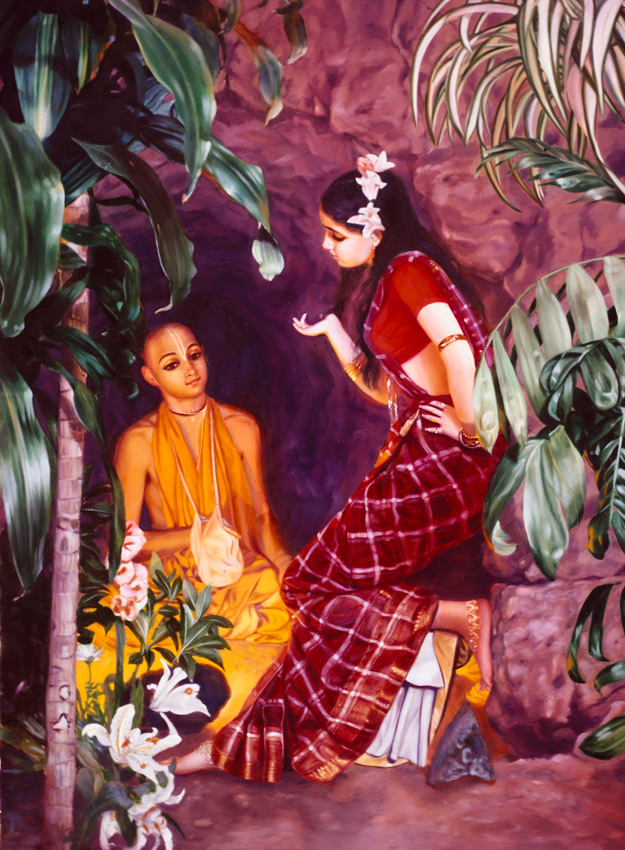 Caitanya Mahāprabhu from Goloka-dhāma, the Lord’s abode in the spiritual world, along with Rūpa Mañjarī and all the other sakhīs.
Caitanya Mahāprabhu from Goloka-dhāma, the Lord’s abode in the spiritual world, along with Rūpa Mañjarī and all the other sakhīs.
In his form as a practising devotee, or sādhaka, Śrīla Raghunātha dāsa Gosvāmī’s dīkṣā–guru and also family guru was Śrīla Yadunandana Ācārya, and he had some association with Śrīla Haridasa Ṭhākura. He also met Śrī Nityānanda Prabhu, and after that he came to Śrī Caitanya Mahāprabhu.
Since his boyhood, Raghunātha dāsa wanted to join Śrī Caitanya Mahāprabhu, but Mahāprabhu advised him not to leave his home, father, and mother so early. Śrīmān Mahāprabhu told him, “First become mature in bhakti, and then you can leave your home. For now, return to your home. Don’t be like a mad person and don’t be anxious. Sometimes, seeing the activities of another person, one becomes enthusiastic and acts impulsively. Later, however, when his ‘fever’ subsides, he understands that he has made a mistake. Now you are a very young child in these religious affairs. Don’t be over-enthusiastic or impatient. Go back and love your father and mother outwardly, yet maintain firm faith in your bhajana. God will help you one day, and you will achieve your ultimate goal.”
Śrī Raghunātha dāsa returned to his parents’ home and lived together with his wife, father, and mother. After 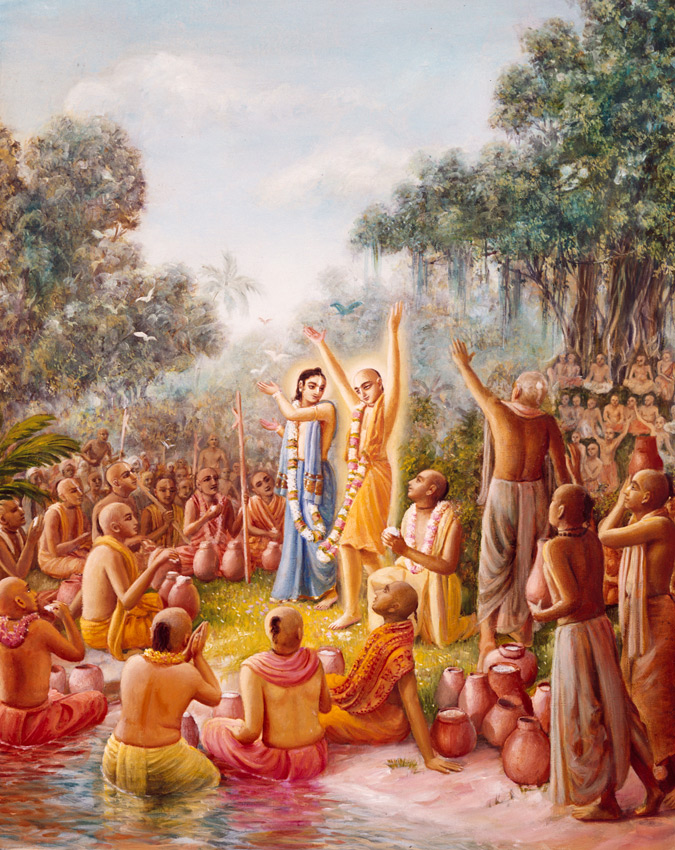 some time he met Śrī Nityānanda Prabhu at Pāṇihāṭi, and there he received the Lord’s mercy. Then, soon after his return from Pāṇihāṭi, his Gurudeva, Śrīla Yadunandana Ācārya, came to his home very early one morning while the sky was still dark. He told Raghunātha dāsa, “One of my disciples has left his service and my Ṭhākura’s pūjā has not been performed. Come with me to that disciple, and let us again engage him in the Ṭhākura’s worship.”
some time he met Śrī Nityānanda Prabhu at Pāṇihāṭi, and there he received the Lord’s mercy. Then, soon after his return from Pāṇihāṭi, his Gurudeva, Śrīla Yadunandana Ācārya, came to his home very early one morning while the sky was still dark. He told Raghunātha dāsa, “One of my disciples has left his service and my Ṭhākura’s pūjā has not been performed. Come with me to that disciple, and let us again engage him in the Ṭhākura’s worship.”
Raghunātha dāsa was very glad because now he could leave his palace without being obstructed. Many guards had been watching over him so he would not leave home, but when they saw that he was with his guru, they did not disturb him. He exited the palace and told his Gurudeva, “You may go to your home. I will go alone to your disciple and send him to you.” His Gurudeva left, and Raghunātha dāsa gave the message to that disciple. The disciple went to his guru, and Raghunātha dāsa quickly went to Jagannātha Purī.
When Raghunātha dāsa arrived in Jagannātha Purī he met Śrī Caitanya Mahāprabhu, who placed him in the hands of Śrī Svarūpa Dāmodara Gosvāmī. Śrīmān Mahāprabhu instructed him thus:
grāmya-kathā nā śunibe, grāmya-vārtā nā kahibe
bhāla nā khāibe āra bhāla nā paribe
amānī mānada hañā kṛṣṇa-nāma sadā la’be
vraje rādhā-kṛṣṇa-sevā mānase karibe
(Śrī Caitanya-caritāmṛta, Antya-līlā 6.236-237)
“Do not talk like people in general or hear what they say. You should not eat very palatable food, nor should you dress very nicely. Do not expect honour, but offer all respect to others. Always chant the holy name of Lord Kṛṣṇa, and within your mind render service to Rādhā and Kṛṣṇa in Vṛndāvana.
There are many pastimes concerning Śrīla Raghunātha dāsa Gosvāmī’s renunciation in Purī and concerning the mercy of Śrī Caitanya Mahāprabhu and Śrī Svarūpa Dāmodara Gosvāmī upon him.
When Caitanya Mahāprabhu left this world, Śrīla Raghunātha dāsa Gosvāmī felt shelterless. He had previously 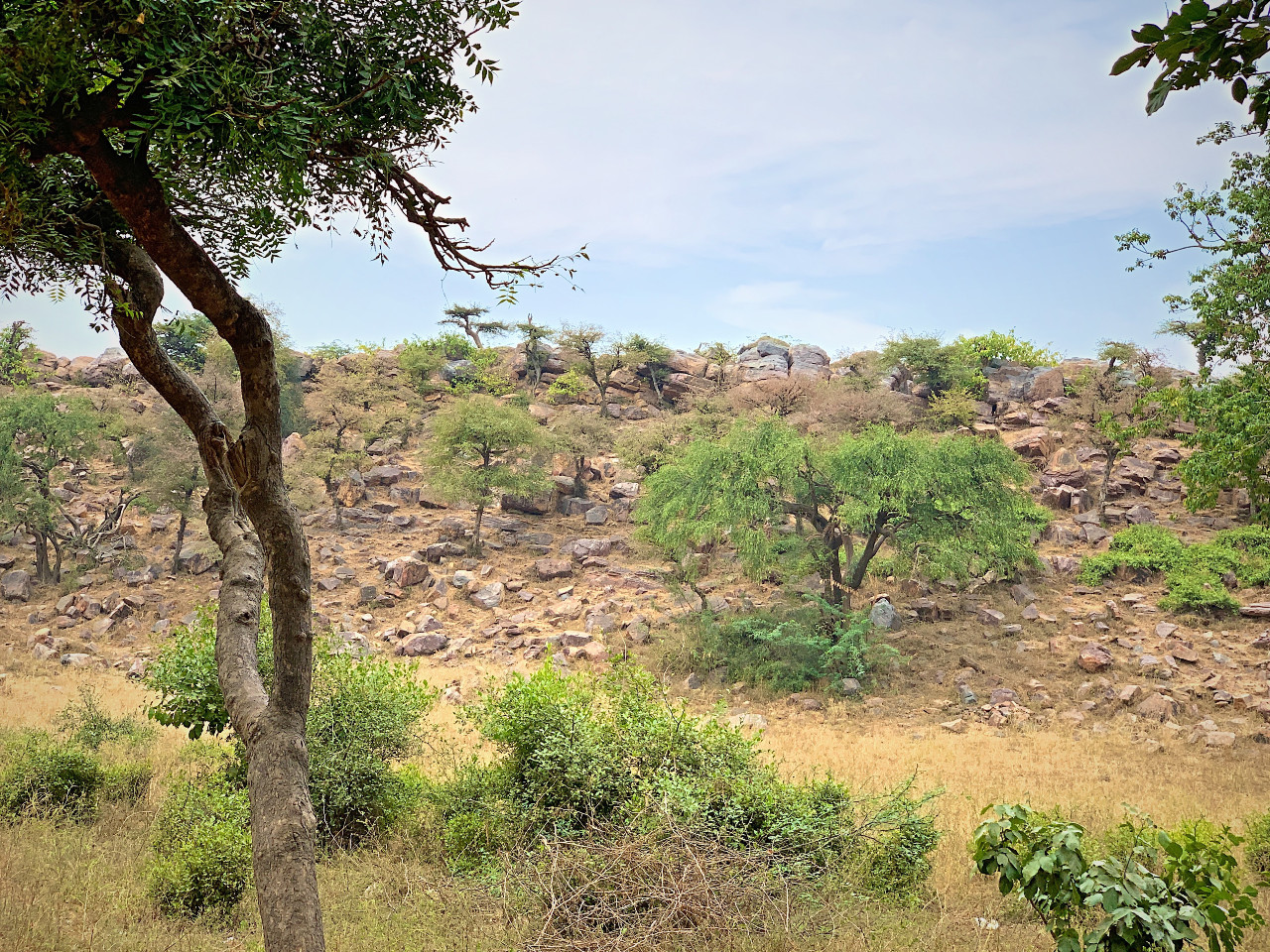 been eating rice, dāl, and so on, but after Śrīmān Mahāprabhu left he took only fruits and milk. Within three- or four months, Śrī Svarūpa Dāmodara also left and joined Śrī Caitanya Mahāprabhu in aprakaṭa-līlā, His eternal pastimes in the spiritual world, and at that time Raghunātha dāsa also gave up taking even fruits and milk. He soon proceeded to Vṛndāvana and planned to give up his life by jumping from Govardhana Hill.
been eating rice, dāl, and so on, but after Śrīmān Mahāprabhu left he took only fruits and milk. Within three- or four months, Śrī Svarūpa Dāmodara also left and joined Śrī Caitanya Mahāprabhu in aprakaṭa-līlā, His eternal pastimes in the spiritual world, and at that time Raghunātha dāsa also gave up taking even fruits and milk. He soon proceeded to Vṛndāvana and planned to give up his life by jumping from Govardhana Hill.
Previously, while he had been living in Jagannātha Purī, Śrī Caitanya Mahāprabhu gave him two Deities: a govardhana-śilā and a guñjā-mālā (necklace of guñjā beads, representing Śrīmatī Rādhikā), which Śaṅkarānanda Sarasvatī had given the Lord upon returning from Vṛndāvana. Śrīmān Mahāprabhu personally used to perform worship of this śilā by offering the water of His tears and the flowers (moods) of His heart. Sometimes He kept it on His heart, sometimes on His head, sometimes on His eyelids, and sometimes He could not find a satisfying place.
After three months Śrīmān Mahāprabhu gave the śilā to Śrīla Raghunātha dāsa Gosvāmī, who considered, “By doing this, Mahāprabhu has given me to Govardhana; I should serve Govardhana. And, by giving me this guñjā-mālā, He has offered me to the lotus feet of Śrīmatī Rādhikā.”
When he performed his worship, Śrīla Raghunatha dāsa Gosvāmī would place the guñjā-mālā around his neck, taking shelter of Śrīmatī Rādhikā. He served Govardhana as Śrī Kṛṣṇa, Vrajendra-nandana Śyāmasundara, and he always thought of himself as a pālya-dāsī, or maidservant, of Śrīmatī Rādhikā – a mañjarī.
He came with these two Deities to Vṛndāvana, and there he met Śrīla Rūpa Gosvāmī and Śrīla Sanātana Gosvāmī. He told them about his idea of going to Govardhana, but he did not disclose his plan to give up his life by jumping from Govardhana. They could understand his intention, however, and Śrīla Sanātana Gosvāmī instructed him, “Don’t do so. You are my brother, and Śrīla Rūpa Gosvāmī’s also.”
Śrīla Sanātana Gosvāmī then told him something from his own life history. He explained that while he was  travelling from Vṛndāvana to Jagannātha Purī he had become infected with a skin disease, the moisture of which was oozing from sores all over his body. As soon as Śrī Caitanya Mahāprabhu saw him He embraced him, at which time the moisture from his body touched the body of Śrīmān Mahāprabhu. Greatly distressed, he thought, “I should leave this body by throwing myself under the wheel of Lord Jagannātha’s chariot.” Śrī Caitanya Mahāprabhu knew about this and told him, “You have given this body to Me, and now you are behaving independently. You give yourself verbally, but internally you do not. You have no right to this body, for you have already surrendered it to Me.”
travelling from Vṛndāvana to Jagannātha Purī he had become infected with a skin disease, the moisture of which was oozing from sores all over his body. As soon as Śrī Caitanya Mahāprabhu saw him He embraced him, at which time the moisture from his body touched the body of Śrīmān Mahāprabhu. Greatly distressed, he thought, “I should leave this body by throwing myself under the wheel of Lord Jagannātha’s chariot.” Śrī Caitanya Mahāprabhu knew about this and told him, “You have given this body to Me, and now you are behaving independently. You give yourself verbally, but internally you do not. You have no right to this body, for you have already surrendered it to Me.”
Śrīmān Mahāprabhu continued, “If I would have thought that by giving up My life I could receive the service of Śrī Śrī Rādhā and Kṛṣṇa, I would want to give up My life hundreds of thousands of times every day. But I know that Kṛṣṇa and kṛṣṇa-prema cannot be attained simply by dying. They can only be achieved by kṛṣṇa-bhajana.”
Śrīla Sanātana Gosvāmī now told Śrīla Raghunātha dāsa Gosvāmī, “So, you can die, but you cannot receive kṛṣṇa-prema by such an act. Rather than die, it is better to perform bhajana at Rādhā-kuṇḍa, Govardhana, Vṛndāvana, and other places of Śrīmatī Rādhārāṇī and Kṛṣṇa’s pastimes.”
In addition to his association with Śrīla Sanātana Gosvāmī, Śrīla Raghunātha dāsa Gosvāmī had a great deal of association with Śrīla Rūpa Gosvāmī. He wholly followed Śrīla Rūpa Gosvāmī, from whom he received all realization about his service to Śrī Śrī Rādhā-Kṛṣṇa, and Śrīla Sanātana Gosvāmī also acted as his śikṣā-guru.
Śrīla Raghunātha dāsa Gosvāmī’s form in kṛṣṇa-līlā
As previously mentioned, in his siddha-śarīra Śrīla Raghunātha dāsa Gosvāmī is a mañjarī, a certain type of sakhī. There are five kinds of sakhīs: sakhī, nitya-sakhī, prāṇa-sakhī, priya-sakhī, and priya-narma-sakhī.
Sakhīs are exemplified by gopīs like Dhaniṣṭhā, who serve and support Kṛṣṇa. Although they serve both Śrīmatī Rādhikā and Śrī Kṛṣṇa, they have more sneha, affection, for Śrī Kṛṣṇa than for Śrīmatī Rādhikā. Thus, they are called kṛṣṇa-snehādhikā gopīs.
Priya-narma-sakhīs are also called parama-preṣṭha-sakhīs, and priya-sakhīs are also called narma-sakhīs. The priya-sakhīs and priya-narma-sakhīs are sama-sneha. The word sama-sneha means that they have equal affection for Rādhā and Kṛṣṇa, yet they are somewhat more attracted to Śrīmatī Rādhikā. They sometimes rebuke Kṛṣṇa when they see Him committing any fault in relation to Śrīmatī Rādhikā, and they sometimes admonish Śrīmatī Rādhikā when She is angry and very hard-hearted towards Śrī Kṛṣṇa. Generally they want that Śrī Kṛṣṇa will always be under the control of Śrīmatī Rādhikā, and they show favouritism towards Her; yet, they are sama-sneha.
The prāṇa-sakhīs and nitya-sakhīs are rādhikā-snehādhikā, meaning they have more affection towards Śrīmatī 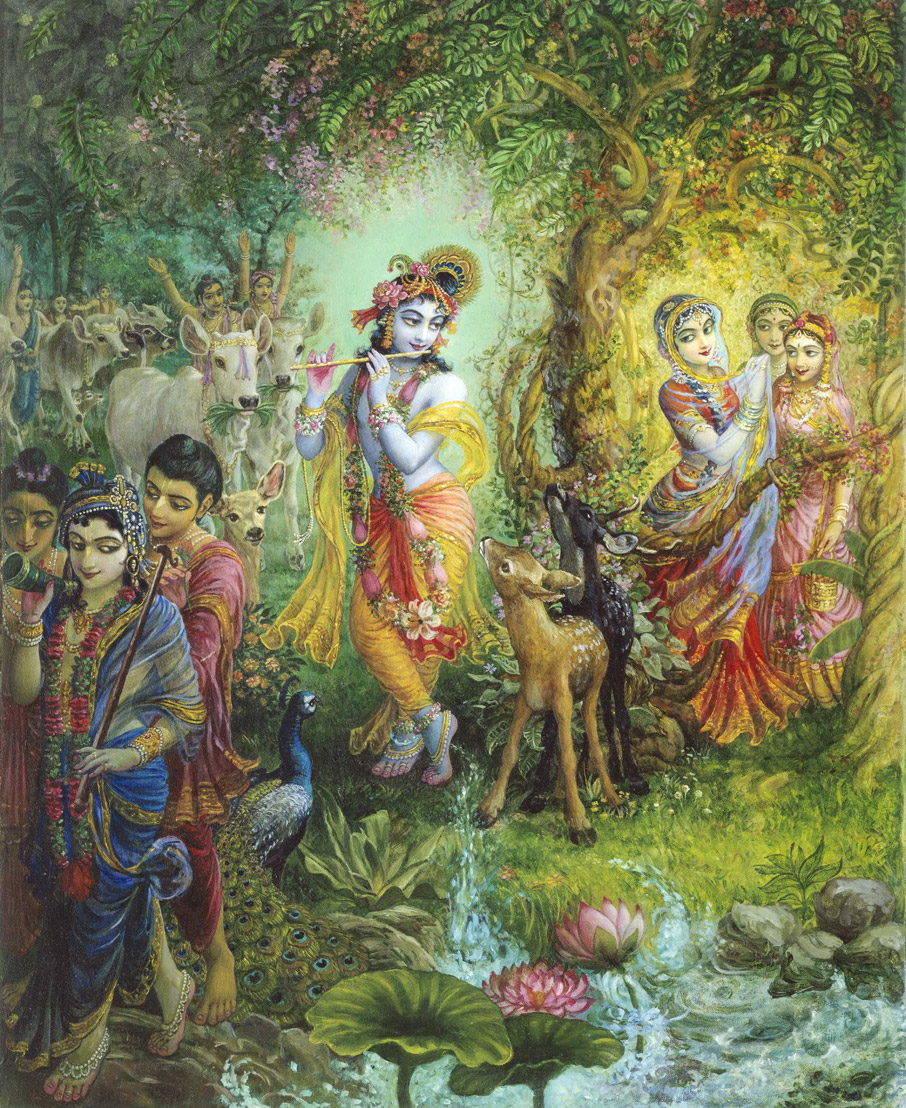 Rādhikā. They always serve Her and associate with Her, wherever She happens to be, and render Her innumerable services. They are extremely pleased if Śrīmatī Rādhikā is pleased. If She feels separation from Kṛṣṇa, they also feel separation; when Kṛṣṇa meets with Her, they feel in their hearts that they themselves are meeting with Him.
Rādhikā. They always serve Her and associate with Her, wherever She happens to be, and render Her innumerable services. They are extremely pleased if Śrīmatī Rādhikā is pleased. If She feels separation from Kṛṣṇa, they also feel separation; when Kṛṣṇa meets with Her, they feel in their hearts that they themselves are meeting with Him.
Their mood is appreciated by the example of a bee playing on a flower. The bee cannot play on the mañjarī of the flower because the mañjarī is not stable, yet when the bee plays on the flower, the mañjarī trembles with happiness. In the same way, when Kṛṣṇa meets with Rādhikā, these mañjarīs become exceedingly happy.
One day Śrīmatī Rādhikā told one of Her sakhīs, for whom she has great affection, “Mani Mañjarī is My very obedient friend. Please go to her and cleverly tell her that Kṛṣṇa is waiting for her in Saṅketa-kuñja (a meeting grove). Please take her to Him by any means. It is My desire that she meet with Him.”
The sakhī went to Mani Mañjarī and requested her in a roundabout way to meet with Kṛṣṇa. She said, “Kṛṣṇa is waiting for you. I also know the desire of Śrīmatī Rādhikā. She has not told me to come to you, but I know Her desire. She will not be angry.”
The sakhī tried to convince her to go in many ways, but Mani Mañjarī said, “Please do not request me to do this. I will never go. When I see Śrīmatī Rādhikā and Śrī Kṛṣṇa meet, I feel so much pleasure, much more pleasure than if I were to personally meet with Him. If a person knows where to achieve greater happiness, he will not purposely strive for lesser happiness. When Kṛṣṇa meets with Rādhikā, it is my gain, but if I would meet with Him, it would be a very great loss. Why should I choose loss over gain?” Thus, Śrīmatī Rādhikā has so much faith in the mañjarīs.
Rādhikā once wanted Śrī Rūpa Mañjarī to meet with Kṛṣṇa. She looked towards Kṛṣṇa and hinted for Him to catch hold of her. Kṛṣṇa wanted to do so, but Rūpa Mañjarī fell at His feet and prayed, “Please don’t do this. I am Rādhikā’s dāsī. When You meet with Her I derive more pleasure than I can describe. I request You to give me that pleasure, not this lesser pleasure.” Kṛṣṇa agreed to her request.
The sādhana to attain this mood of devotion is called tat-tad-bhāva-icchātmikā. Tat-tad-bhāva-icchāmayī is one of the two types of kāmānuga-bhakti, and the other is sambhoga-icchāmayī. Aspiring to become an independent nāyikā (heroine) like Śrīmatī Rādhikā and Candrāvalī is called sambhoga-icchāmayī, which means the desire to have a direct relationship with Kṛṣṇa. Those gopīs who become greatly pleased by witnessing the meeting of Śrī Śrī Rādhā-Kṛṣṇa and who experience all the symptoms of directly meeting Kṛṣṇa simply by seeing Śrī Rādhā and Śrī Kṛṣṇa meet are called sakhī snehādhikā. They experience what Rādhikā has experienced with Kṛṣṇa, which is more than what they would have experienced by directly meeting with Him. Tat-tad-bhāva means ‘the speciality of the meeting of Rādhā and Kṛṣṇa, and its bhāva.’ Although the mañjarīs have all the qualities of the nāyikā, or other heroines, if not more, they only want to serve Śrī Rādhā. Śrī Rūpa Mañjarī and Śrī Rati Mañjarī are both in this category. The sādhana to attain this devotion is therefore called tat-tad-bhāva-icchātmikā.
How can this type of devotion be attained? Śrī Caitanya Mahāprabhu has come to this world only to give this bhāva – not the love of Śrīmatī Rādhikā or the love of a nāyikā.
anarpita-carīṁ cirāt karuṇayāvatīrṇaḥ kalau
samarpayitum unnatojjvala-rasāṁ sva-bhakti-śriyam
hariḥ puraṭa-sundara-dyuti-kadamba-sandīpitaḥ
sadā hṛdaya-kandare sphuratu vaḥ śacī-nandanaḥ
(Śrī Caitanya-caritāmṛta, Ādi-līlā 1.4)
[May the Supreme Lord who is known as the son of Śrīmatī Śacī-devī be transcendentally situated in the innermost chambers of your heart. Resplendent with the radiance of molten gold, He has appeared in the Age of Kali by His causeless mercy to bestow what no incarnation has ever offered before: the most sublime and radiant mellow of devotional service, the mellow of conjugal love.]
He has appeared in the age of Kali by His causeless mercy to bestow what no incarnation ever offered before: the most sublime and radiant spiritual knowledge of the mellow taste of His service.
Sva-bhakti-śriyam is that unnatojjvala-rasa, or elevated conjugal mellow, which can be attained by the jīva soul. The soul cannot have what Śrīmatī Rādhikā has – mahābhāva* in both mādana and modana** – in exactly the same way that She has it. Śrī Caitanya Mahāprabhu came to taste rādhā-bhāva, Rādhikā’s transcendental ecstatic sentiments, and śrī-rādhāyāḥ praṇaya-mahimā, the glory of Her love. He came also to distribute mañjarī-bhāva, engagement in the service of Śrīmatī Rādhikā and Śrī Kṛṣṇa.
Śrīla Rūpa Gosvāmī and Śrīla Sanātana Gosvāmī thus advised Śrīla Raghunātha dāsa Gosvāmī, and they gave him Rādhā-kuṇḍa as his place to live and perform bhajana. There he was always crying for Śrīmatī Rādhikā, and always rolling in the dust of the bank of Rādhā-kuṇḍa.
Although he is a special sakhī of Śrīmatī Rādhikā and is never separated from Her, in this līlā, as Śrīla Raghunātha dāsa Gosvāmī, he has played the highest role of a jīva – a rāgānugā-sādhaka, a practising devotee  who desires the service of the mañjarīs.
who desires the service of the mañjarīs.
He was not merely pretending. By the arrangement of Yogamāyā he actually felt himself to be a sādhaka. Although Lord Kṛṣṇa is God of Gods, He weeps by seeing the stick in the hand of Mother Yaśodā. He is not pretending. He actually fears Mother Yaśodā, and therefore, He genuinely weeps. Similarly, although Śrīla Raghunātha dāsa Gosvāmī is a near and dear sakhī of Śrīmatī Rādhikā in his spiritual form as a mañjarī, he is not pretending to feel greed to achieve that service. By the influence of Yogamāyā he does what he actually feels. He has two roles: one as a practising rāgānugā-bhakti-sādhaka, and at the same time another, in his siddha-śarīra, as Śrī Rati Mañjarī, who is always serving Rādhā and Kṛṣṇa.
bāhya, antara, — ihāra dui ta’ sādhana
‘bāhye’ sādhaka-dehe kare śravaṇa-kīrtana
‘mane’ nija-siddha-deha kariyā bhāvana
rātri-dine kare vraje kṛṣṇera sevana
(Śrī Caitanya-caritāmṛta, Madhya-līlā 22.156-157)
“There are two processes by which one may execute this rāgānugā bhakti — external and internal. When self-realized, the advanced devotee externally remains like a neophyte and executes all the śāstric injunctions, especially those concerning hearing and chanting. But within his mind, in his original, purified, self-realized position, he serves Kṛṣṇa in Vṛndāvana in his particular way. He serves Kṛṣṇa twenty-four hours a day, all day and night.
Every jīva has a siddha-deha, or siddha-śarīra (spiritual body). Without a siddha-deha one cannot serve Śrī Rādhā and Śrī Kṛṣṇa. This material body is not fit for serving Them. In Śrī Caitanya Mahāprabhu’s pastimes, one can perform bhajana and sādhana with this body, but for mānasa-cintana, meditating on and entering Rādhā and Kṛṣṇa’s pastimes, the siddha-deha is essential.
This can be achieved if a person has greed, if he has gone to a siddha-gurudeva, and if he is very eager to serve Rādhā and Kṛṣṇa. Initially his Gurudeva will cause him to hear all Their pastimes. The guru will watch and see in which rasa the disciple has taste. Accordingly, he will let him hear the pastimes that will be appropriate and useful for him.
When bhāva manifests in one’s body, one becomes situated in the stage called svarūpa-siddha (internal cognizance of one’s spiritual identity). After attaining this svarūpa-siddha, one can ‘imagine’ these pastimes, but the word imagination has a specific meaning here. There is some realization.
Suppose a devotee is hearing a verse of Śrīla Raghunātha dāsa Gosvāmī from the lips of a pure guru. In that verse, Śrī Rati Mañjarī smiles as she tells Śrī Rūpa Mañjarī, “O Rūpa Mañjarī, I know that you are a very chaste lady in Vṛndāvana. Everyone knows this; although your husband has been out of the home for many days, I see some unusual marks on your lips. Why is that? Perhaps a parrot came while you were sleeping; thinking your lips to be a bimba fruit, he has bitten and cut them.”
In another verse Śrīla Raghunātha dāsa Gosvāmī has written:
śrī-rūpa-mañjari-karārcita-pāda-
padmagoṣṭhendra-nandana-bhujārpita-
mastakāyāḥ hā modataḥ kanaka-gauri-
padāravindasamvāhanāni śanakais tava kiṁ
(Śrī Vilāpa-kusumāñjali, text 72)
[O Devī as fair as gold, Your lotus feet are worshipped by Śrī Rūpa Mañjarī’s hands as You rest Your head against Kṛṣṇa’s arm. When will I receive the remnants of Rūpa Mañjarī’s service and happily and gently massage Your lotus feet?]
Śrīmatī Rādhikā and Śrī Kṛṣṇa are tired from wandering in Vṛndāvana and performing Their pastimes in the kuñjas. They are perspiring and their faces look very beautiful. Śrīmatī Rādhikā is lying on the lap of Lord Kṛṣṇa, keeping Her feet on the lap of Śrī Rūpa Mañjarī, and Rūpa Mañjarī is massaging Her feet ever so softly. Kṛṣṇa is caressing Śrīmatī Rādhikā’s hair and She is feeling great happiness on His lap. Śrīla Raghunātha dāsa Gosvāmī, in the mood of Rati Mañjarī, is praying to Rūpa Mañjarī, “Will you give me your prasādī sevā?” Prasāda means remnant. “Rūpa Mañjarī is massaging. Will she give her ‘remnant service’ to me?”
If one remembers this pastime, is the remembrance imagination? The pastime is reality. Therefore, the meaning of ‘imagination’ in this connection is thinking about the pastimes performed by Śrī Kṛṣṇa and Śrīmatī Rādhikā, but without realization. If one first hears the pastimes from a bona fide guru and then thinks about them without realization, is this imagination? The subject matter is true. Although there is no realization, something is there, and after this ‘imagination’ the devotee will have some realization. He continues to hear more and more, and he continues his practices of rāgānugā-bhajana. Then, gradually, his siddha-śarīra will manifest by the grace of Śrī Kṛṣṇacandra, Śrīmatī Rādhikā, and Yogamāyā.
By thinking alone, however, one cannot achieve anything. These pastimes manifest in the heart only by the grace of Bhagavān Śrī Kṛṣṇa. If the guru is qualified, if he is a śuddha-guru (pure guru) and realises all the pastimes; he will also help. He will see the rasa of his disciple’s siddha-śarīra – as did the guru of Vrajanātha and Vijaya Kumāra of Jaiva-dharma – and give him appropriate guidance for his spiritual development.
If a person is situated in rāgānugā-bhakti, spontaneous devotion following in the wake of the residents of Vṛndāvana, he will surely understand his spiritual form and try hard to achieve it by the grace of Lord Kṛṣṇa and Śrī Śrī Guru and Gaurāṅga. Without this, one cannot factually meditate upon aṣṭa-yāma-līlā, the pastimes that Śrī Śrī Rādhā-Kṛṣṇa perform throughout the day and night. Without this, he does not know who he is, nor has he any idea of Kṛṣṇa or Rādhikā – how beautiful They are and what Their qualities are. He should know his/her sevā (particular service), vasana (dress), bhūṣaṇa (decoration), āyu (age), husband, father-in-law, mother-in-law, sister-in-law, residence, and the place in which her marriage was performed. He will have to know all the elements of his spiritual personality, the realization of which comes at the stage of svarūpa-siddhi.
When the devotee becomes matured in this practice, Yogamāyā will take him, after death, to a sphere where Śrī Kṛṣṇa’s līlā is going on in the material world. The devotee will take her birth in a gopī’s womb and, in the association of nitya-siddha (eternally perfect) gopīs, she will completely realize and serve Śrīmatī Rādhārāṇī and Śrī Kṛṣṇa.
We are advised to think of Śrīla Raghunātha dāsa Gosvāmī as a rāgānugā-sādhaka, not as siddha (eternally perfected devotee). There is no doubt that he is siddha, a mañjarī, but we can only follow him if we see him as a rāgānugā-sādhaka. In our present stage we cannot follow Kṛṣṇa or any siddha mahā-puruṣa. We can only follow sādhakas. We therefore consider Śrīla Raghunātha dāsa Gosvāmī as a sādhaka, and we can gradually follow how he performed his sādhana, or spiritual practices.
Here, Raghunātha dāsa Gosvāmī weeps on the bank of Rādhā-kuṇḍa towards the end of his life when he is 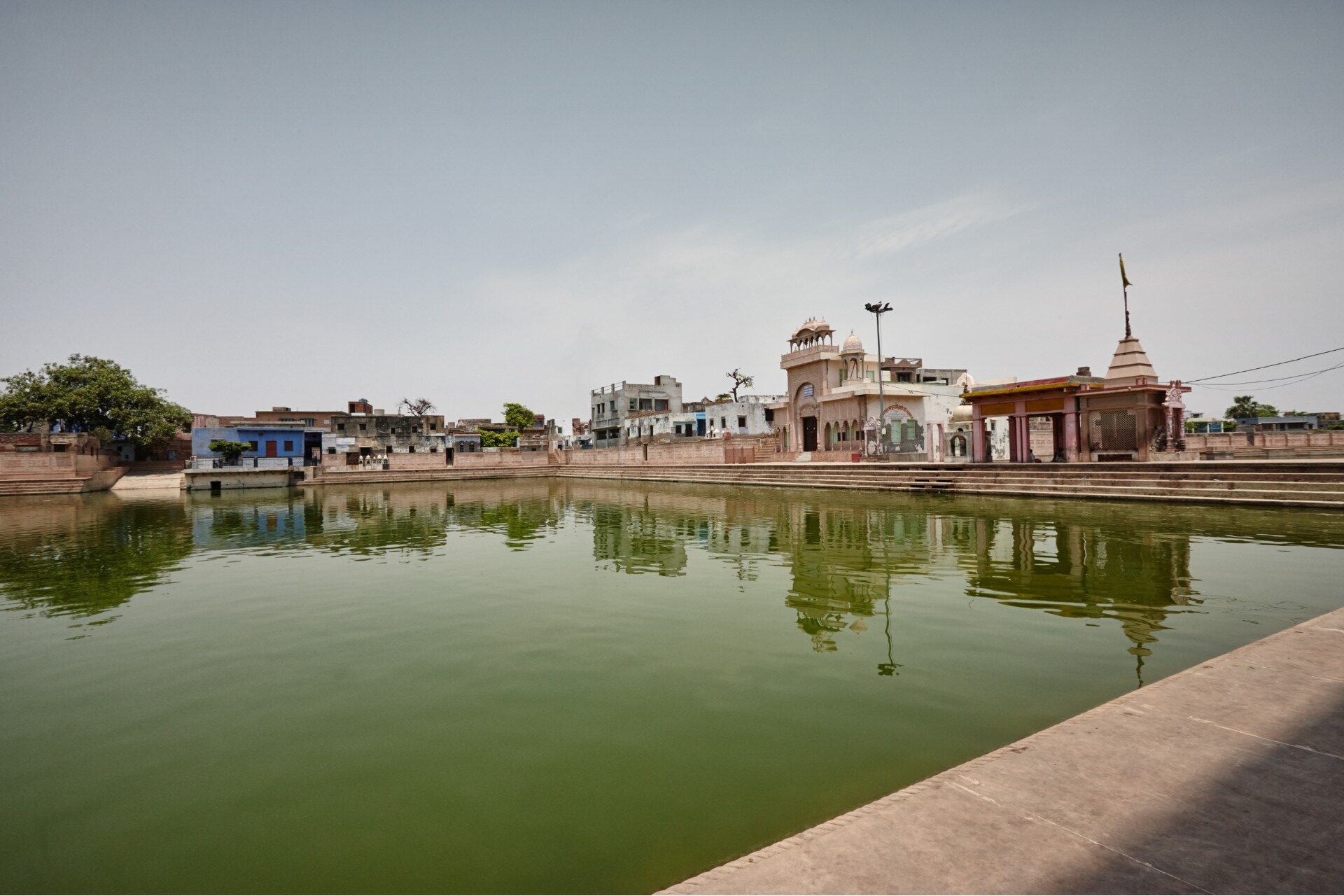 not able to live without the darśana of Śrīmatī Rādhikā for even a second. Feeling great separation, he prays to Her for service.
not able to live without the darśana of Śrīmatī Rādhikā for even a second. Feeling great separation, he prays to Her for service.
His prayers are flowers. Vilāpa means ‘weeping,’ and that weeping is his palmfuls (āñjali) of numerous varieties of flowers (kusuma) which he offers to Śrīmatī Rādhikā’s lotus feet. In each service reside unique moods or bhāvas. When Raghunātha dāsa Gosvāmī has one kind of mood of separation and is praying for a specific service, that is one kind of flower. There are so many flowers in the form of one hundred and four verses, and all the verses are uttered only for achieving mañjarī-bhāva. None are for achieving nāyikā-bhāva, the mood of becoming the beloved of Śrī Kṛṣṇa and having a direct relationship with Him.
* Mahābhāva – the highest stage of prema, divine love. In Ujjvala-nīlamaṇi (14.154) mahābhāva is defined thus: “When anurāga reaches a special state of intensity, it is known as bhāva or mahābhāva. This stage of intensity has three characteristics:
(1) anurāga reaches the state of sva-saṁvedya, which means that it becomes the object of its own experience; (2) it becomes prakāśita, radiantly manifest, which means that all eight sāttvika-bhāvas become prominently displayed; and (3) it attains the state of yāvad-āśraya-vṛtti, which means that the active ingredient of the intensified state of anurāga transmits the experience of Rādhā and Kṛṣṇa’s bhāva to whoever may be present and qualified to receive it.”
** Vijaya: How many types of adhirūḍha are there?
Gosvāmī: There are two types, modana and mādana.
Vijaya: What is modana?
Gosvāmī: The adhirūḍha-mahābhāva in which all the sāttvika-bhāvas of the nāyaka and nāyikā are aroused to a much greater extent than in the uddīpta condition is called modana. In this modana-bhāva, Kṛṣṇa and Rādhā feel some anguish and fear.
Vijaya: Please describe the position of modana.
Gosvāmī: Modana does not occur anywhere other than in the yūtha of Śrī Rādhikā. Modana is the dearest and most delightful pleasure sport of the hlādinī-śakti. In some special conditions of separation, modana becomes mohana, and as an effect of this helpless condition of separation, all the sāttvika-bhāvas manifest in the sūddīpta condition.
(Jaiva-dharma, chapter 36)
“Highly advanced ecstasy is divided into two categories — mādana and mohana. Meeting together is called mādana, and separation is called mohana. On the mādana platform there are kissing and many other symptoms, which are unlimited. In the mohana stage, there are two divisions — udghūrṇā [unsteadiness] and citra-jalpa [varieties of mad emotional talks]. Mad emotional talks include ten divisions, called prajalpa and other names. An example of this is the ten verses spoken by Śrīmatī Rādhārāṇī called ‘The Song to the Bumblebee.’
“In conjugal love [śṛṅgāra] there are two departments — meeting and separation. On the platform of meeting, there are unlimited varieties that are beyond description.
“When the lover and the beloved meet, they are called yukta (connected). Previous to their meeting, they are called ayukta (not connected). Whether connected or not connected, the ecstatic emotion arising due to not being able to embrace and kiss each other as desired is called vipralambha. This vipralambha helps nourish emotions at the time of meeting.” Similarly, sambhoga is described in the following verse quoted from the Vedic literature by Śrīla Bhaktisiddhānta Sarasvatī Ṭhākura in his Anubhāṣya: “Meeting each other and embracing each other are aimed at bringing about the happiness of the lover and the beloved. When this stage becomes increasingly jubilant, the resultant ecstatic emotion is called sambhoga.”
(Śrī Caitanya-caritamrta, Madhya-līlā 23.58–62, part of 23.62 purport included)
Source: Purebhakti.com
Image(s) made possible by Pixabay.com, Krishnapath.org and/or Bhaktiart.net
Unless indicated differently, all verse translations and quotes are from the books by Śrīla Prabhupāda (Vedabase.com)
[ad_2]
#life #Śrīla #Raghunātha #dāsa #Gosvāmī







